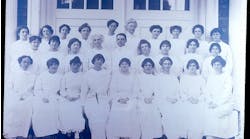by Trisha O'Hehir
It was a cold, dreary Friday in November 1969. Rain streaked the windshield and ran in tiny diagonal rivers along the side windows. Riding in the back seat of a convertible in such cold, gloomy weather was still a treat because it meant a day off. They picked me up at 9 a.m., more than an hour later than my workday usually began. The drive would take an hour and give the three of us time for getting-to-know-you conversation. I knew the other hygienist and had just met the dentist who was driving us to the meeting. As the conversation drifted to dental topics, the dentist caught my eye in the rearview mirror and asked point blank, "Are you good at what you do?"
Holy cow! How did he find out that I was a terrible student at the bottom of my class who moved to Zurich in the hopes no one would find out I had no idea what I was doing? Since I was so far from home, I hoped they would take pity on me and not send me back to Minnesota! Oh my gosh, did this guy know all this?
No, there was no way he could. I had just met him. He didn't even know where I'd gone to school. I resumed breathing, realizing my secret was still safe.
In that split second I decided to be the person I wanted to be, the person who it was my goal to become. With only the conviction that some day it might be true, I confidently said, "Yes, I'm very good at what I do."
While the conversation continued, I was dying in the back seat, waiting for lightning to strike after telling such a big lie. Then I realized that no one else thought my answer was out of the ordinary. They actually believed me. I was amazed! But now that I said it, I was going to have to figure out how to become that person.
With that goal in mind I plowed forward each day asking questions, watching my employers perform perio surgery to see where I missed calculus, and taking continuing education courses whenever I could. This was all done in my quest to live up to the lie/goal I had blurted out that cold November morning in Switzerland.
But the harder I worked, the longer it took me to finish a patient. My friends all took coffee breaks, left on time for lunch and never stayed late. What was I doing wrong?
Nothing. I learned a lot during those four years in Switzerland. I just didn't figure that out until I got back to Minnesota, where I taught students in the clinic. I had become the hygienist who was good at what she did. Wow, was I surprised!
Then it happened again. Point-blank, right between the eyes. I never saw it coming. This time it happened in Tucson in 1984 in my operatory. After a thorough periodontal exam, as I was discussing the finding and case presentation including non-surgical therapy, the patient looked me in the eye and asked, "What's your success rate with this treatment? What percentage of these pockets do you heal?"
Your whole life can flash before your eyes in a fraction of a second - it's true! I had no idea what the percentage was. I knew I was getting good results. Not very many patients needed surgery after going through the non-surgical treatment. But a percentage! "Quick," I told myself. "Think of something to say!" Gathering up what confidence I could muster, I proudly announced, "My success rate is approximately 85 percent."
I didn't want to say 75 percent, that sounded like making a "C" and 99 percent sounded too much like the Ivory soap commercial. So I threw out a number in-between. Even as I said it, it didn't sound too bad. The patient was satisfied and agreed to begin treatment. Whew, I was off the hook again.
But his question haunted me. What was the real answer? How successful was I? I'd been doing this for 18 years and I didn't even know how successful I was. I vowed right then and there to figure out my success rate.
Checking the Perio-Data(tm) charting forms of 30 patients who had completed treatment and had at least one maintenance visit gave me what I needed. Adding numbers in the monitoring boxes, I found 1,916 pockets before treatment and 139 pockets after treatment. Looks like my wild guess of 85 percent was too low. Based on the pockets of these particular patients, nearly 93 percent were eliminated. I was even more successful than I imagined! What a morale boosting surprise that was.
Have you ever been asked if you're good at what you do, or what your success rate is? If you haven't been asked, figure it out so you'll be ready with the answer. Simply total the number of pockets the patient starts with and ends with, then calculate the percentage of those eliminated.
Our goal is to eliminate all the pockets so the end score after treatment will be zero. Calculations will then be easy. Zero divided by the number of pockets to start, then subtracted from 1.0 and multiplied by 100. There's your success rate - 100 percent if all the pockets are eliminated.
From my sample of 30 patients, the ending number of 139 is an average of five pockets per patient. Actually, four people ended with zero pockets and the remaining 26 had from one to 13 pockets at the end.
Research studies don't routinely report treatment success. If they report the number of pockets at the start of the study and the number of pockets at the end of the study, you can calculate their success rate yourself. Instead most studies report an average change in pocket depth scores rather than the change in the number of pockets. Other studies only evaluate two teeth in each quadrant so overall treatment success data isn't available.
In a Swedish study by Dr. Badersten of 15 patients in the mid 1980s, patients began with a total of 411 pockets and ended after therapy and maintenance two years later with 56 pockets. Dividing 56 by 411 gives you 0.14. Subtract from 1.00 to get 0.86 and then multiply by 100 and the success rate is 86 percent.
By the way, these patients had hand instruments used in two quadrants, power scalers in the other two quadrants, and maintenance care for two years. Healing was similar for both hand and power instrumentation. That was the real purpose of the study. I simply calculated the success rate from the pocket depth data presented.
Comparing apples and oranges is a dangerous thing to do with research.
My data was retrospective, while theirs was prospective. I included molars; they didn't. I did my instrumentation and they did theirs. We used different instruments and different probes. My point is not to compare the results, but to show you that treatment success is easily calculated. I encourage you to calculate your treatment success. It's easy when you have the data.
Start with just one patient, one who healed particularly well. Calculate your success rate on that patient and then add more patients to your calculations as they come in to see you.
When you're asked if you're good at what you do and what your treatment success rate is, you'll be ready.
Just say, "I'm very good at what I do and my success rate at eliminating pockets is even better than Trisha O'Hehir's. It's fill-in-the-blank percent." :)





